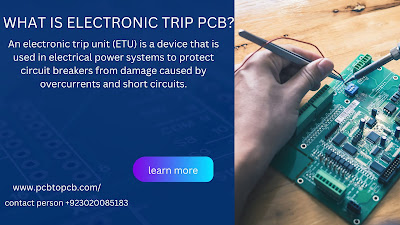what is electronic trip pcb
An electronic trip unit (ETU) is a device that is installed in a circuit breaker to protect electrical systems from damage caused by overcurrents or short circuits. It functions by detecting when an overcurrent or short circuit occurs and then opening the circuit breaker to interrupt the electrical current. The ETU typically consists of a printed circuit board (PCB) that houses the electronic components that control the operation of the circuit breaker.
The PCB in an ETU serves as the platform for the electronic components that make up the device. It is a thin board made of insulating material, usually made of fiberglass or some other type of composite material, that has conductive pathways etched onto its surface. These pathways connect the various electronic components, such as transistors, diodes, and resistors, that make up the ETU. unction
 |
| what is electronic trip pcb |
The electronic components on the PCB are chosen and arranged to perform specific fns within the ETU. For example, there may be electronic components that detect the current flowing through the circuit and compare it to a set point, or threshold, to determine if an overcurrent or short circuit has occurred. Other components may be used to control the operation of the circuit breaker, such as opening or closing the contacts that interrupt the electrical current.
The PCB in an ETU is also used to provide power to the electronic components.
This is typically done through the use of power supply circuits, which convert the incoming AC power to the DC power needed by the electronic components. The PCB also includes various protection circuits to protect the electronic components from damage due to overvoltage, overcurrent, or other conditions that could cause damage.
One of the key features of the ETU is its ability to adjust the trip setting to match the specific requirements of the electrical system it is protecting. This is typically done through the use of software or firmware that is stored on the PCB and can be programmed or reprogrammed as needed. This allows the ETU to be easily adapted to different types of electrical systems and different levels of protection.
The use of electronic trip units (ETUs) in circuit breakers has several advantages over traditional mechanical trip units. For example, electronic trip units can provide more precise overcurrent protection, they can respond more quickly to an overcurrent or short circuit, they can provide a wider range of trip settings, and they can be more easily programmed to match the specific requirements of an electrical system.
In conclusion, an electronic trip unit (ETU) is an device that is installed in a circuit breaker to protect electrical systems from damage caused by overcurrents or short circuits. It typically consists of a printed circuit board (PCB) that houses the electronic components that control the operation of the circuit breaker.
The PCB serves as the platform for the electronic components and provides power and protection to the electronic components. The ETU is able to adjust the trip setting to match the specific requirements of the electrical system it is protecting.





0 Comments